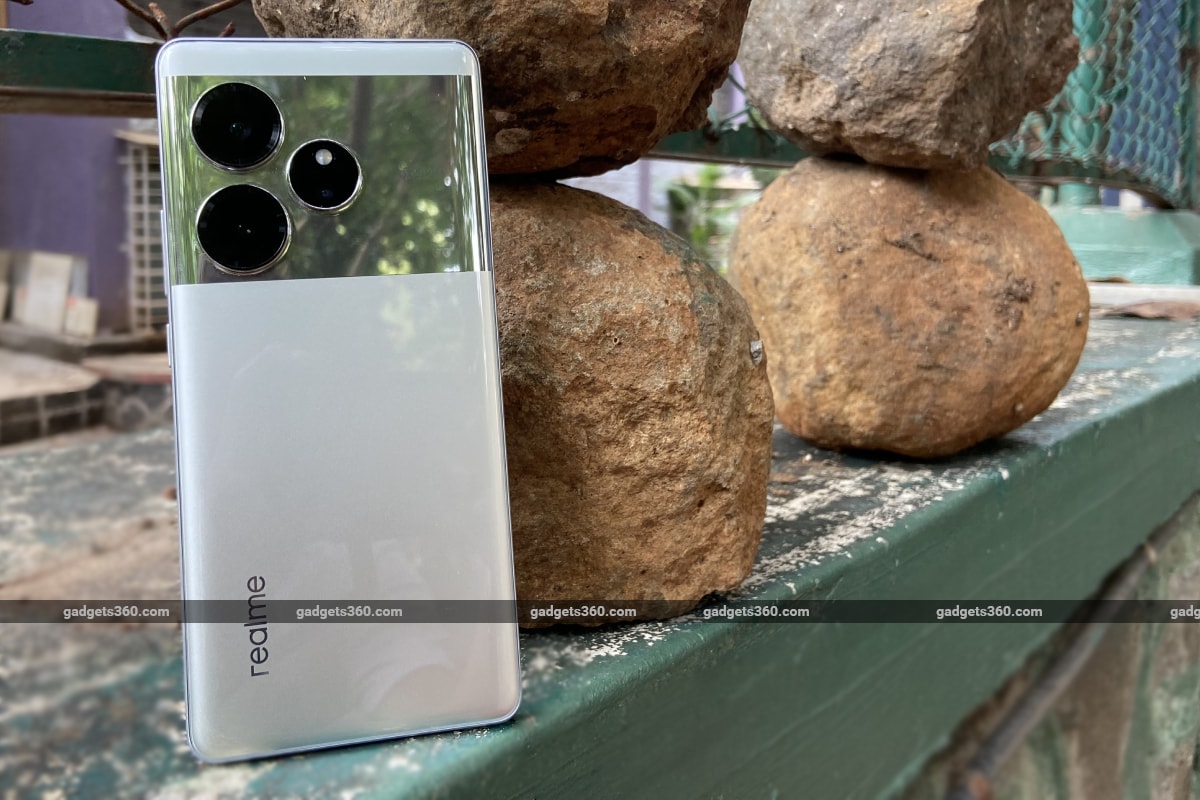
Realme GT 6 runs on Android 14-based Realme UI 5 (tap to expand)
As far as software is concerned, the Realme GT 6 runs on Android 14 out-of-the-box, with the company’s Realme UI 5 skin on top. The handset comes with five preinstalled third-party apps — Amazon, Finshell Pay, Myntra, ORoaming, Snapchat — that can be uninstalled. The software on the phone adds useful features on top of Google’s operating system including a dedicated gaming mode, ‘air gestures’, and the ability to use a pair of wired earphones and a wireless headset at the same time.
This is also Realme’s first AI-branded phone, and the company has equipped the GT 6 with its ‘Next AI’ that improves low light camera performance, allows you to remove objects from photos, and suggests actions to perform by analysing the content of your screen. Realme says that the phone will get three Android OS and security updates followed by a fourth year of security updates.
Realme GT 6 has an AI Eraser mode that is mostly reliable, but you might notice a bit of blurring
On the connectivity front, the Realme GT 6 offers support for Wi-Fi 6, 5G, 4G LTE, Bluetooth 5.4, GPS, as well as a USB Type-C port for charging and data transfers. The company has also equipped the handset with an IR transmitter that can control a wide range of appliances — I tested it with a TV, home theatre system, and a few air conditioners during the time I spent testing this phone.
Realme GT 6 Review: Performance
With its Snapdragon 8s Gen 3 chipset and ample RAM, the Realme GT 6 is capable of handling both day-to-day tasks and demanding workloads with no issues. This included editing a 4K video and exporting it on InShot, hours of gaming, and lots of browsing the web and social media apps.
I tested Genshin Impact and Call of Duty: Warzone Mobile on the Realme GT 6 on the highest supported settings selected by default in both games. These are two of the most demanding titles you can play on an Android phone, and there was no lag, stuttering, throttling or overheating, even after an hour of gaming. The built-in gaming mode also lets you turn on optimisations for HDR content, touch response, and pick between battery saving or performance modes.
![]()
Realme GT 6 can handle heavy titles like Genshin Impact without any lag or stutter
Realme GT 6 synthetic benchmark test results (tap to expand)
The Realme GT 6 was on par or slightly ahead with the Poco F6, its rival with the same Snapdragon 8s Gen 3 processor, on most synthetic tests. You can refer to the table below to see how the phone fared in both CPU and graphics benchmarks, compared to the Poco phone as well another handset with a slightly more powerful Snapdragon 8 Gen 2 chip, the iQoo Neo 9 Pro.
| Benchmark | Realme GT 6 | Poco F6 | iQoo Neo 9 Pro |
|---|---|---|---|
| Geekbench 6 Single Core | 1944 | 1835 | 2050 |
| Geekbench 6 Multi Core | 4895 | 4693 | 5741 |
| AnTuTu v10 | 1,405,190 | 1,457,491 | 1,585,868 |
| PCMark Work 3.0 | 18,828 | 15,743 | 13,319 |
| 3DMark Wild Life | Maxed Out | Maxed Out | Maxed Out |
| 3DMark Wild Life Unlimited | 11325 | 11734 | 12789 |
| 3DMark Sling Shot | Maxed Out | Maxed Out | Maxed Out |
| 3DMark Sling Shot Extreme | Maxed Out | Maxed Out | Maxed Out |
| GFXBench Car Chase | 60 | 71 | 85 |
| GFXBench Manhattan 3.1 | 60 | 112 | 119 |
| GFXBench T-Rex | 60 | 120 | 120 |
Like most phones launched this year, the Realme GT 6 runs on Android 14, with Realme UI 5. The software feels well optimised, there are no promotional messages, and a few preinstalled apps can either be disabled or uninstalled. RAM management is optimal, and I didn’t notice any recently used apps being kicked out of memory when I switched back to them. Like other Realme handsets, you have to agree to separate privacy and usage agreements before opening some system apps.
The Realme GT 6 features a 6.78-inch Full-HD+ (1,264×2,780 pixels) LTPO AMOLED screen with a dynamic refresh rate that ranges between 1Hz and 120Hz, and a 360Hz touch sampling rate. The display gets plenty bright when automatic brightness is enabled, and you can see details on the screen even when you’re outdoors and using the phone in bright sunlight. There’s a toggle that lets you ramp up the screen brightness beyond the original limit, but it also comes at the cost of increased battery drain.
![]()
Realme GT 6 sports a large AMOLED screen that is usable in bright sunlight
There’s a 5,500mAh battery powering this Realme handset and it lasted for 21 hours and 7 minutes during our HD battery video loop test. In terms of actual usage, I managed to get about 7 hours of screen on time before I had to plug it into the charger at 5 percent. It can be fully charged in 29 minutes on average, using the included 120W SuperVOOC charging brick. The phone has a glass back, but there’s no support for wireless charging on the handset.
Realme GT 6 Review: Cameras
The Realme GT 6 is equipped with three rear cameras — a 50-megapixel primary camera with a Sony LYT-808 sensor, an 8-megapixel ultra-wide angle camera with a Sony IMX355 sensor, and a 50-megapixel telephoto camera with a Samsung JN5 sensor. The handset also has a 32-megapixel selfie camera on the front with an unspecified sensor.
All three cameras on the Realme GT 6 perform well during the day (tap to expand)
The telephoto camera lets you take detailed images of subjects without getting too close (tap to expand)
The best camera sensor on the handset is the primary camera, which captures images that are clear with accurate colours. Zooming into these images shows that there is enough detail, assuming there’s enough light. In low-light scenarios, the camera still captures good photos in the default mode, and you can switch to a dedicated Night mode that takes brighter images in under a second.
The ultra-wide angle camera offers images with a considerably lower resolution and slightly darker than the primary camera, but it’s handy for clicking larger subjects that aren’t too far away. There’s also no noticeable warping around the edges. In low-light scenarios, the camera captures photos that have less detail compared to the primary camera, and I found myself using the latter when there wasn’t enough lighting.
If you have subjects that are far away, the telephoto camera on the Realme GT 6 can capture sharp images at 2x and 4x optical zoom. The colours on images captured by the telephoto camera are slightly less vivid than the primary camera. In darker scenarios, zooming in on distant subjects produces photos with a little bit of noise and softening. If you zoom past 15x, the camera interface displays an indicator that tells you when to hit the capture button.
Ultra-wide angle shots from the Realme GT 6 appear darker than images from the other cameras (tap to expand)
The ultra-wide angle camera on the Realme GT 6 doesn’t perform as well in low-light conditions
The telephoto camera on the Realme GT 6 captures clear images with the inbuilt Night mode (tap to expand)
The primary and telephoto cameras let you capture video at up to 4K/ 60fps, but if you want to use the built-in ultra steady mode, you’ll need to record at 1080p/ 60fps and use the primary camera — this is the best option when recording videos while walking around. The ultra-wide angle camera lets you capture videos at up to 1080p/ 30fps.
For selfies, the front facing camera can deliver detailed images after you disable the ‘beautification’ features. The photos captured by the selfie camera look good when there’s enough light, and slightly blurry in low-light scenarios.
You can also use the primary and telephoto camera to record videos in Dolby Vision, at up to 4K/ 30fps, and while these videos are brighter and offer more contrast, it’s worth noting that you can only view them on Dolby Vision compatible displays. Meanwhile, videos captured using the front facing camera are good during the day, but the quality drops considerably at night.
Realme GT 6 Review: Verdict
If you’re in the market for a new smartphone priced around Rs. 40,000 in India, it’s easy to recommend the Realme GT 6, which offers a good mix of performance, battery life with fast charging support, and reliable cameras. I encountered no issues during casual use, voice calls, and gaming on the handset, over the course of the review.
There’s a lot of competition from similarly priced phones, in this price segment. The iQoo Neo 9 Pro (Review) and OnePlus 12R (Review) feature the more powerful Snapdragon 8 Gen 2 SoC, but the Realme GT 6 offers a more versatile camera setup.
Meanwhile, if performance is your primary consideration, you can also look at the recently launched Poco F6 (Review) which has the same processor as this Realme handset but is available at a much lower price point. Other less-powerful options worth considering include the Samsung Galaxy S23 FE (Review) and the Google Pixel 7a (Review), and both these phones come with Samsung and Google-exclusive features.


